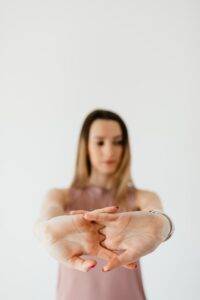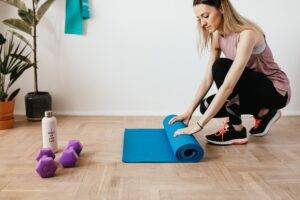Pilates is a physical fitness system developed in the early 20th century by Joseph Pilates. It is a form of exercise that focuses on strengthening the body through a series of low- impact movements, often performed on a mat or on specialized equipment. Pilates can be modified to accommodate people of all fitness levels and can be performed by people of all ages. The goal of Pilates is to improve flexibility, strength, and balance, and to develop a strong core through control and precision in movement. It is often used as a form of physical therapy and is also popular as a form of general exercise for improving overall physical fitness.
impact movements, often performed on a mat or on specialized equipment. Pilates can be modified to accommodate people of all fitness levels and can be performed by people of all ages. The goal of Pilates is to improve flexibility, strength, and balance, and to develop a strong core through control and precision in movement. It is often used as a form of physical therapy and is also popular as a form of general exercise for improving overall physical fitness.
Joseph Pilates was the founder of the Pilates method of exercise. He was born in Germany in the 1880s and became interested in physical fitness at an early age. Pilates believed that physical and mental health were closely connected, and he developed his exercise method as a way to strengthen the body and mind. He spent many years studying various forms of exercise and movement, including yoga, gymnastics, and martial arts, and he eventually created his own system of exercise that he called “Contrology.”
During the First World War, Joseph Pilates was interned in a detention camp in England along with other German nationals. During the war, many foreign nationals were interned in detention camps as a precautionary measure to prevent them from potentially aiding the enemy. Pilates was one of these individuals and was interned in a camp on the Isle of Man along with other German nationals. While he was interned, Pilates continued to develop and teach his system of exercise, which he believed could be used to help improve overall health and fitness as well as to aid in physical rehabilitation.
While in the camp, Pilates began teaching his system of exercise to other prisoners and also used it to help rehabilitate injured soldiers. He believed that his method could help to improve overall health and fitness and could also be used as a form of physical therapy to help people recover from injuries. Pilates used various pieces of equipment that he designed and built himself, including springs and pulleys, to provide resistance and support for his clients as they performed his exercises. His work in the detention camp during the First World War helped to establish Pilates as a pioneer in the field of physical fitness and rehabilitation. Pilates immigrated to the United States in the 1920s and opened a studio in New York City, where he taught his method of exercise to a small group of students. The method became popular in the 1960s and 1970s, and it continues to be practised by people all over the world today.
Pilates can be an effective form of exercise for people with diet problems, as it can help to improve overall physical fitness and may also have other health benefits. However, Pilates should not be considered a replacement for a healthy diet and may not have a significant impact on weight loss or other diet-related goals on its own.
However, Pilates should not be considered a replacement for a healthy diet and may not have a significant impact on weight loss or other diet-related goals on its own.
That being said, regular physical activity, including Pilates, can be an important part of a healthy lifestyle and may help to support weight loss and weight management efforts when combined with a healthy diet. Exercise can help to increase metabolism, improve cardiovascular health, and boost mood and energy levels, which can all contribute to a healthier lifestyle. If you are interested in using Pilates as part of a weight loss or diet program, it is important to consult with a healthcare provider or a qualified Pilates instructor to determine a plan that is safe and appropriate for you.
Pilates and yoga are both forms of exercise that involve physical movement and can have many similar benefits. Both practices can help to improve flexibility, strength, and balance, and may also have other health benefits, such as reducing stress and improving mental clarity.
However, there are also some differences between Pilates and yoga. Pilates is  typically focused on strengthening and toning the body through precise and controlled movements, while yoga involves a wider range of movements and poses that may be more flowing and dynamic. Pilates is often performed on a mat or on specialized equipment, while yoga can be done on a mat or with the use of props. Pilates is generally a low-impact form of exercise, while some types of yoga can be more physically demanding.
typically focused on strengthening and toning the body through precise and controlled movements, while yoga involves a wider range of movements and poses that may be more flowing and dynamic. Pilates is often performed on a mat or on specialized equipment, while yoga can be done on a mat or with the use of props. Pilates is generally a low-impact form of exercise, while some types of yoga can be more physically demanding.
Ultimately, the choice between Pilates and yoga will depend on your personal fitness goals and preferences. Both practices can be beneficial and can be incorporated into a healthy lifestyle, so it may be worth trying both to see which one works best for you.
The Pilates Foundation is a UK-based organization that promotes the practice of Pilates and supports the professional development of Pilates instructors. The Pilates Foundation was established in 1999 and is dedicated to ensuring the quality and integrity of Pilates instruction in the UK. It offers a range of resources and services for Pilates instructors and practitioners, including training programs, workshops, and professional development opportunities. The Pilates Foundation also works to raise awareness of the benefits of Pilates and to support research into the practice. If you are interested in becoming a Pilates instructor or in finding a qualified instructor in the UK, the Pilates Foundation may be able to help.

